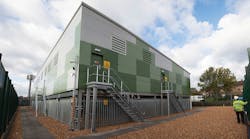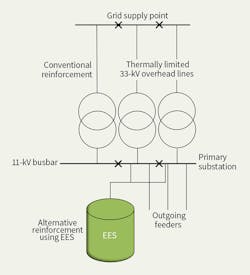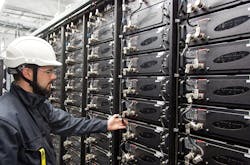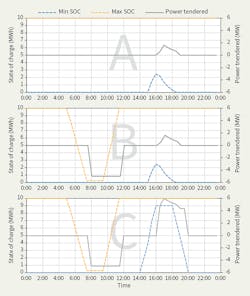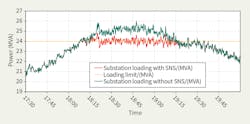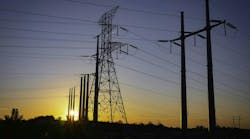Grid-scale electrical energy storage (EES) has many applications within power networks, including peak shaving, frequency response, short-term operating reserve and supporting intermittent generation. However, installing EES for a single application is typically insufficient to justify capital investment. The principle goal of the UK Power Networks Smarter Network Storage (SNS) project is to install large-scale EES and optimize its use for a variety of system benefits to maximize its value.
As part of the SNS project, one of the largest batteries in Europe — 10 MWh, 6 MW, 7.5 MVA of lithium-ion storage — has been installed at a 33/11-kV primary substation in Bedfordshire, England. The purpose of the EES is to defer the need to invest in new network infrastructure by reducing peak demand. Additionally, to offset investment costs, revenue will be gained from contracts to provide frequency response and short-term operating reserve, and energy traders will be offered a tolling contract as well. With this project, UK Power Networks aims to demonstrate how EES on this scale can serve as a network asset while delivering a return on investment. The success of the demonstration will build confidence in commercial deployment of EES and prove a route to wide-scale adoption.
These objectives present both commercial and technical challenges. Electricity demand at the primary substation needs to be forecasted over long-term time horizons to enable the tendering of commercial contracts. These same demands must be forecasted over short-term time horizons to schedule services and state-of-charge (SOC) adjustments in the face of demand volatility. Services must be identified and scheduled to maximize revenue from the EES. When a daily schedule is passed to the real-time energy storage management system to control the SOC, real and reactive power set points need to dispatch the battery in line with contracted services and the requirements of distribution network operators.
Trial Site and System
The Leighton Buzzard 33/11-kV substation was selected as the site for the SNS project. The site is connected to a 132-kV transmission system supply point by two 33-kV overhead lines. As the peak demand is sufficiently high for several days each year, it is possible one of these lines would not be sufficient to supply all customers in the event of an outage. Soon the substation would fail to comply with the N-1 security supply standard. Therefore, in accordance with the UK’s distribution network standards, network reinforcement or an alternative intervention was required.
Conventionally, this would require the construction of an additional 33-kV overhead line as well as the installation of a 38-MVA, 33/11-kV transformer. However, this solution would involve large capital investment and provide additional capacity far more than the required reinforcement. The proposed alternative was to employ EES to supply the demand locally when required, thereby reducing the load on the existing 33-kV overhead lines to within the load-transfer capability.
However, the EES is more expensive in terms of capital expenditure than constructing an additional overhead line and transformer. Consequently, the EES tenders for commercial balancing services when not being used for the peak shaving service. This generates additional revenues to offset the capital cost and, ultimately, demonstrates a range of ways to achieve a satisfactory rate of return on the investment.
Fully Controllable Asset
EES is unlike most network assets as it is a fully controllable, limited resource; this means effective planning, over multiple time horizons, is required to achieve optimum usage. Demand forecasting enables scheduling to account for likely future demand. This is essential to allocate energy to the primary peak shaving function, and, subsequently, assign the remaining power and energy to commercial services.
Both long- and short-term forecasts are required. Many of the commercial services are tendered for weeks, or even months, in advance, necessitating a long-term forecast. A more accurate short-term forecast then allows the battery resources to be distributed more precisely. Cost-based, security-constrained optimization is required to select a combination of services that maximizes the expected revenue from the EES.
Finally, scheduling enables instructions to be programmed for the EES, and for its activities to be visualized and understood easily. None of the services offered by the EES are guaranteed to be required. Peak shaving will only be delivered if there is a network outage and the commercial services will only be delivered in response to a customer request for service. This means the schedule must be sufficiently robust to ensure future services can be delivered, regardless of the past services.
The Methodology
Multiple linear regression was used to implement the forecast; the demand is predicted as the weighted sum of several explanatory variables. The weighting terms are calculated through offline analysis of historical load data. The main challenge in creating a multiple linear regression model is determining which subset of the available explanatory variables results in the most accurate forecast.
The variables used for long-term forecasting are time of day, day of week, month, type of day, day or night, and daylight savings. The short-term forecasts also make use of forecast temperature and past demand, which are not available for longer time horizons.
Service Scheduling
Peak shaving refers to the reduction of electricity demand at times of peak consumption. The electricity demand varies throughout the day; in the UK, this peak typically occurs in the early evening. In many cases, the peak demand only occurs for a relatively short period. However, the generation, transmission system and distribution networks must be designed, planned and built to supply the peak demand. Peak shaving reduces the demand peak by offsetting the demand with locally supplied power.
Commercial Services
To justify investing in SNS rather than conventional reinforcement, EES must offer commercial services. The various services available for SNS systems are primarily available through National Grid, the UK transmission system operator, and pertain to transmission system operation. Additional services are available through energy supply utilities and distributed energy resource aggregators. The services tendered for by the SNS-EES are as follows:
- Short-term operating reserve (STOR) services are offered to provide energy in times of likely shortfalls.
- Commercial firm-frequency response (FFR) services are used to either maintain the frequency within regulations (50 ±0.5 Hz in the UK) or bring the frequency back to 50 Hz following a period of deviation, such as particularly high or low demand. This service requires either supply or absorption of energy.
- Tolling service differs from STOR and FFR in that it is not offered by National Grid to solve a network issue. Instead, tolling represents handing over the operation of the EES to a third party for a fixed fee.
- Triad is not a commercial service as such, but it does represent an opportunity for significant revenues from the EES. In the UK, the three highest demand half-hours in a year (not within 10 days of one another) are the Triad periods and represent the periods in which higher transmission costs occur. By providing energy during the Triad periods, EES can generate revenue by either receiving the inverse of the charge directly or — if metered by an energy supply utility, as is the case with SNS — reducing the cost to the energy supply utility and receiving an agreed proportion of the savings.
Power and Energy Allocation
When scheduling services, whether they are commercial or required by the network, the EES must have sufficient energy, available power and sufficient network capacity to deliver the service. If these resources are not properly managed, services may not be delivered; this would lead to financial penalties for commercial services and could lead to customer disconnection and associated penalties for a peak shaving service. To avoid this occurrence, a method for scheduling services — accounting for the constraints on power and energy of the EES — has been developed in three steps:
1. Give priority to peak shaving. Because the priority of SNS is to ensure security of supply for customers, peak shaving must be added into the schedule before any commercial services are considered. The demand forecast is used to identify periods of high demand. The power needed to supply demand above the network capacity is reserved, as this energy is required. Finally, a SOC adjustment is added to complete the scheduling. This can take the form of charging prior to the service or recharging after the service; in either case, the SOC adjustments can be overwritten by future services, provided the new services will enable the EES to perform the peak shaving service.
2. Layer in commercial services. Following peak shaving, commercial services are added one at a time, with each service forming a new layer. The time and duration of the service are specified, as are the maximum power and delivery time (for example, a service may be available for 3 hours, but only contracted to deliver energy for a 30-minute window). The power tendered by the service is constrained by the energy and power requirements already set aside for peak shaving. When adding new services, the potential SOC ranges — based on the service being either delivered or not delivered — are considered to ensure no future service is dependent on a previous service.
3. Estimate the service valuation and selection. Once the levels of power and energy that can be tendered for each service combination have been evaluated, the commercial value must be estimated. The value of any service is a combination of an availability fee, a delivery fee, the value of the energy exchange and the likelihood of the service being delivered.
To consider an example, an ideal situation for the EES would appear to be scheduling alternating power-to-grid and power-from-grid services. In this situation, the EES would receive revenue for both charging and discharging. However, in reality, the services may not be delivered most of the time. This means costly SOC adjustments must take place between the services, resulting in a reduction in value and degradation of the battery. It would be more profitable in this case to schedule only power-to-grid services, meaning the SOC would only have to be adjusted after service delivery takes place.
Commissioning and Operation
The project commenced in January 2013. An extensive testing and trial period began, following the commissioning of the ESS in November 2014. The first quarter of 2015 was used for detailed testing and integration of all storage subsystems while providing support to the local distribution network and transmission network, by exporting power when required to relieve from peaks in load demand. The second and third quarters of 2015 saw trialing of reserve services to the transmission system operator and extensive testing for the response services provision. The last quarter of 2015 saw the successful enrollment of the first ESS in the UK transmission system operator’s frequency-response program.
The storage system has undergone extensive optimized services trials in which a multitude of services were concurrently trialed to gain learning from optimized operation. The asset transitioned to a business as usual operation in January 2017. Through its project lifetime, it provided more than 8500 hours of service to the transmission system operator and supported the local distribution network on more than 1000 hours.
Acknowledgments
This article is based on a paper presented at CIRED 2015 in Lyon, France. The project was supported by OFGEM, the UK regulator, through the Low Carbon Network Fund. The authors would like to thank their project partners at AMT-SYBEX, Swanbarton Ltd., Poyry Management Consulting, Younicos, National Grid, S&C Electric Co., Smartest Energy, Imperial College London and Kiwi Power. ♦
Panagiotis Papadopoulos joined UK Power Networks Services in August 2016 to lead technology development on distributed energy resources, smart grids and energy storage. He holds a BSEE degree and two MSc degrees. His Ph.D and post-doctoral work focused on the integration of EVs and other DERs into electricity systems. Previously, Panos led operations for one of Europe’s largest energy storage systems owned by UK Power Networks. He is a chartered engineer and member of CIGRE, IEEE and IET.
Christos Keramisanos is a senior engineer in UK Power Networks Services. His experience spans power and energy project engineering and delivery in the UK and numerous solar photovoltaic and C&I projects in Greece. Christos currently focuses in developing distributed energy resources projects and leads the operations of the Smarter Network Storage.
Adriana Laguna is the low-carbon technologies and external engagement manager at UK Power Networks. Previously, Laguna worked at Acciona Energy, developing 300 MW of wind energy in Mexico, and worked in the Ministry of Energy in Mexico, helping to design Mexico’s first renewable energy program. She holds a Master of Public Administration degree in environmental science and policy from Columbia University and a BS degree in industrial engineering from Instituto Tecnológico Autónomo de México.
David Greenwood is a researcher working at Newcastle University in the UK. His work focuses on smart grids and energy storage, with an interest in probabilistic methods and the impact of meteorological phenomena on power systems. This research is done in collaboration with industry, particularly distribution network operators. He completed a Ph.D., in collaboration with Scottish Power Energy Networks, at Newcastle University in 2014.
Neal Wade is a lecturer in energy distribution at Newcastle University’s School of Electrical and Electronic Engineering. He specializes in electricity distribution and off-grid power sectors, and leads projects that address the need to cost-efficiently decarbonize the power sector over the next 30 years by investigating the innovative network integration of new generation and demand technologies.
